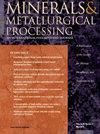Magnetic conditioning of sulfide minerals to improve recovery of fines in flotation — a plant practice
Q2 Materials Science
引用次数: 2
Abstract
In flotation practices, as particles become finer, such as smaller than 20 µm, process efficiency declines markedly. Selective agglomeration of fine particles is a technique to enhance the recovery of fine valuable minerals in flotation circuits. Different agglomerating methods have been introduced and tested. One method that has recently received much attention is to make use of magnetic force to aggregate fine particles. A selective aggregation of fine paramagnetic particles, such as sulfide minerals, can be achieved in the high-intensity magnetic field prior to or during flotation. The method is simple, selective and effective for fine particles and has low operational cost, though a minimum magnetic susceptibility for fine grains is required to promote the process.In this paper, the implementation of the ProFlote magnetic conditioning device in Boliden’s Garpenberg old concentrator in Sweden, where a complex massive sulfide ore is treated, is presented and discussed based on Boliden’s Garpenberg plant. The results showed an increase in the flotation recovery of fine valuable minerals. Zinc (Zn) production was increased by between 1,100 and 1,500 t/a, while salable yearly silver (Ag) production was increased by 1,500 kg. The copper (Cu) grade in the final concentrate was increased by 1 percent, while reductions in its Zn and lead (Pb) grades were obtained. Moreover, considerable reduction in Zn deportment to the final tail was observed.硫化矿物磁调节提高浮选细粒回收率的工厂实践
在浮选实践中,随着颗粒变得更细,例如小于20µm,工艺效率显著下降。细颗粒选择性团聚是提高浮选过程中细粒有价矿物回收率的一种技术。介绍并测试了不同的凝聚方法。最近受到广泛关注的一种方法是利用磁力使微粒聚集。细顺磁性颗粒(如硫化矿物)的选择性聚集可以在浮选前或浮选过程中的高强度磁场中实现。该方法对细颗粒具有简单、选择性和有效性,操作成本低,但对细颗粒的磁化率要求最低。本文以瑞典Boliden公司Garpenberg厂为例,介绍了ProFlote磁调节装置在瑞典Boliden公司Garpenberg老选矿厂处理复杂块状硫化物矿石的实施情况。结果表明,细粒有价矿物的浮选回收率有所提高。锌(Zn)产量增加了1100至1500吨/年,而可销售的银(Ag)产量增加了1500公斤/年。最终精矿铜品位提高1%,锌、铅品位降低。此外,观察到最终尾部的Zn态明显减少。
本文章由计算机程序翻译,如有差异,请以英文原文为准。
求助全文
约1分钟内获得全文
求助全文
来源期刊

Minerals & Metallurgical Processing
工程技术-矿业与矿物加工
CiteScore
0.84
自引率
0.00%
发文量
0
审稿时长
>12 weeks
期刊介绍:
For over twenty-five years, M&MP has been your source for the newest thinking in the processing of minerals and metals. We cover the latest developments in a wide range of applicable disciplines, from metallurgy to computer science to environmental engineering. Our authors, experts from industry, academia and the government, present state-of-the-art research from around the globe.
 求助内容:
求助内容: 应助结果提醒方式:
应助结果提醒方式:


